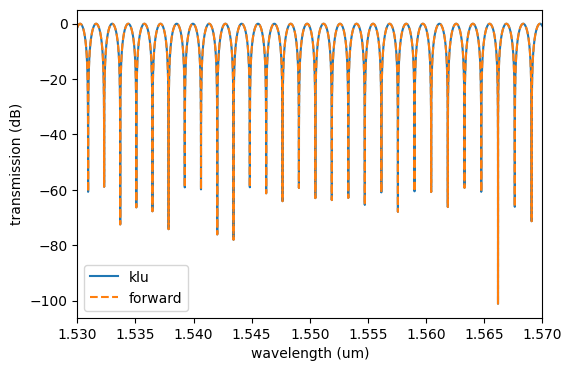Forward-only Backend#
An efficient backend when the components in circuit have low back-reflection. In this case, only forward-direction matrix multiplication is calculated to reduce computational cost for complicated circuit. The improvement compared to other backends (‘klu’ for example) is demonstrated with an example of cascaded AMZI structure.
This notebook as well as the forward-only backend itself was contributed by zhetaoj.
import sax
import jax.numpy as jnp
import numpy as np
import matplotlib.pyplot as plt
Define waveguide and directional coupler components
def waveguide(wl=1.55, wl0=1.55, neff=2.34, ng=3.4, length=10.0, loss=0.0) -> sax.SDict:
dwl = wl - wl0
dneff_dwl = (ng - neff) / wl0
neff = neff - dwl * dneff_dwl
phase = 2 * jnp.pi * neff * length / wl
transmission = 10 ** (-loss * length / 20) * jnp.exp(1j * phase)
sdict = sax.reciprocal(
{
("in0", "out0"): transmission,
}
)
return sdict
def coupler(coupling=0.5) -> sax.SDict:
kappa = coupling**0.5
tau = (1 - coupling) ** 0.5
coupler_dict = sax.reciprocal(
{
("in0", "out0"): tau,
("in0", "out1"): 1j * kappa,
("in1", "out0"): 1j * kappa,
("in1", "out1"): tau,
}
)
return coupler_dict
Create a cascaded AMZI structure with n identical AMZIs, with the next AMZI is connected to the “cross” port of the previous one.
def cascaded_amzi_generator(n, backend="klu"):
netlist = {
"instances": {},
"connections": {},
"ports": {},
}
models = {
"coupler": coupler,
"waveguide": waveguide,
}
# Build the netlist
for i in range(1, n + 1):
# Define instance names
left_name = f"left_{i}"
right_name = f"right_{i}"
top_name = f"top_{i}"
btm_name = f"btm_{i}"
# Add instances
netlist["instances"][left_name] = "coupler"
netlist["instances"][right_name] = "coupler"
netlist["instances"][top_name] = "waveguide"
netlist["instances"][btm_name] = "waveguide"
# Internal connections within AMZI i
netlist["connections"][f"{left_name},out0"] = f"{btm_name},in0"
netlist["connections"][f"{btm_name},out0"] = f"{right_name},in0"
netlist["connections"][f"{left_name},out1"] = f"{top_name},in0"
netlist["connections"][f"{top_name},out0"] = f"{right_name},in1"
if i > 1:
# Connections between AMZIs via the cross port
prev_right_name = f"right_{i - 1}"
netlist["connections"][f"{prev_right_name},out0"] = f"{left_name},in1"
netlist["connections"][f"{prev_right_name},out1"] = f"{left_name},in0"
# Define external ports
netlist["ports"]["in0"] = "left_1,in0"
netlist["ports"]["in1"] = "left_1,in1"
netlist["ports"]["out0"] = f"right_{n},out0"
netlist["ports"]["out1"] = f"right_{n},out1"
# Create the circuit
mzi_ideal, info = sax.circuit(netlist=netlist, models=models, backend=backend)
return mzi_ideal, info
Consider a case with 20 cascaded AMZIs
wavelengths = np.linspace(1.500, 1.600, 100_000)
n = 10
params = {"wl": wavelengths}
for i in range(1, n + 1):
params[f"left_{i}"] = {"coupling": 0.5}
params[f"right_{i}"] = {"coupling": 0.5}
params[f"top_{i}"] = {"length": 50}
params[f"btm_{i}"] = {"length": 0}
Run simulation with ‘klu’ backend and ‘forward-only’ backend
%%time
mzi_ideal, info = cascaded_amzi_generator(n, backend="klu")
S = mzi_ideal(**params)
transmissions_klu = 10 * jnp.log10(jnp.abs(S["in0", "out1"]) ** 2)
CPU times: user 6.74 s, sys: 2.67 s, total: 9.42 s
Wall time: 11.1 s
%%time
mzi_ideal, info = cascaded_amzi_generator(n, backend="forward")
S = mzi_ideal(**params)
transmissions_forward = 10 * jnp.log10(jnp.abs(S["in0", "out1"]) ** 2)
CPU times: user 450 ms, sys: 146 ms, total: 596 ms
Wall time: 560 ms
As the circuit becomes more complex, the forward-only backend experiences a more significant speed-up, and the results remain accurate as long as there is no backreflection.
fig, axs = plt.subplots(figsize=(6, 4))
plt.plot(wavelengths, transmissions_klu, label="klu")
plt.plot(wavelengths, transmissions_forward, "--", label="forward")
plt.xlim(1.53, 1.57)
plt.xlabel("wavelength (um)")
plt.ylabel("transmission (dB)")
plt.legend()
plt.show()



